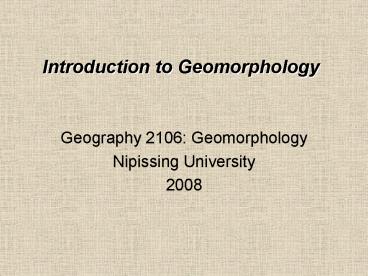Introduction to Geomorphology PowerPoint PPT Presentation
1 / 15
Title: Introduction to Geomorphology
1
Introduction to Geomorphology
- Geography 2106 Geomorphology
- Nipissing University
- 2008
2
Overview
- What is Geomorphology?
- Development of Geomorphology
- Process Geomorphology
- Systems Approach
- Driving and Resisting Forces
3
What is Geomorphology?
- a) The study of the morphology or form of the
Earths surface - b) Defn
- The study of landforms on or near the Earths
surface and the processes working on them.
4
What is Geomorphology?
- c) A discipline w/ close ties to other
sub-disciplines in Physical Geography and the
Earth Sciences - d) It is a science, but it has strong
"connections" w/ the humanities - e) Taught w/in Geography or Geology
5
Development of Geomorphology
- a) In the 17th early 18th century, surface
features of the earth were commonly attributed
to catastrophic, often biblical-like events - - a school of thought referred to as
"catastrophism"
6
Development of Geomorphology
- b) During the late 18th 19th century, the
works of Hutton, Playfair, Lyell introduced the
concept of uniformitarianism - c) By the late 19th century, Gilbert postulated
that landforms reflect an adjustment btwn
geomorphic processes and geology
7
Development of Geomorphology
- d) But geomorphologists were lured away by the
Davisian model of landform development (see fig
1.1)
8
Development of Geomorphology
- e) By the mid 20th century, there was a return to
the importance of the relationship btwn form and
process - - fuelled in large part by the quantitative
revolution
9
Development of Geomorphology
- f) The concept of dynamic equilibrium was
re-born, as landforms were seen as adjusting to
the processes operating on the geology - - and consequently, process and form share a
cause and effect relationship - g) The emphasis on form and process led to the
development of Process Geomorphology
10
Process Geomorphology
- a) A dynamic equilibrium exists btwn landforms
and processes, but it is continually being
adjusted - - driving forces vs. resisting forces
- b) Major changes in the driving forces may
disrupt the equilibrium temporarily or result in
a new equilibrium
11
Process Geomorphology
- c) Processes are multivariate and interrelated
- d) Process Magnitude Frequency
- e) Different time frames for the study of
geomorphic systems see fig 1.5
12
Process Geomorphology
- f) Complexities
- i) Thresholds
- ii) Stores
- iii) Non-linear relationships
- iv) Multiple relationships
13
Systems Theory
- Defn
- A system is a collection of related components
interconnected by flows of energy and matter - - e.g. a drainage basin
- The flows of energy and matter are dynamically
balanced by the system w/in certain thresholds, - i.e. a dynamic equilibrium
14
Systems Theory
- c) Types of Thresholds
- Extrinsic threshold
- Intrinsic threshold
- d) Responses
- Negative Feedback
- Positive Feedback
- Complex Responses
- (see fig 1.4)
15
Systems Theory
- e) Advantages for Geomorphology
- i) Emphasis can be placed on the relationship
btwn form and process - ii) Stresses the multivariate nature of
geomorphology - iii) Balance is a dynamic concept
- iv) Time

